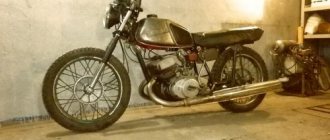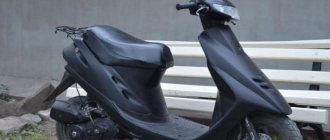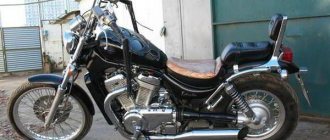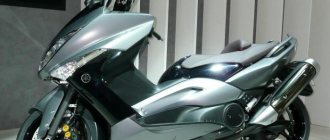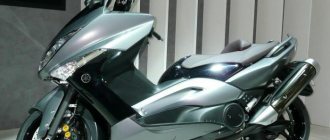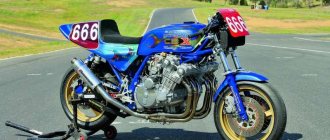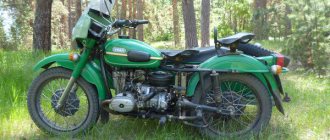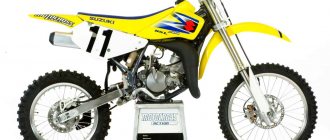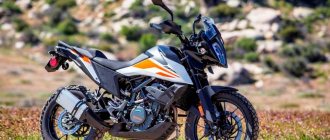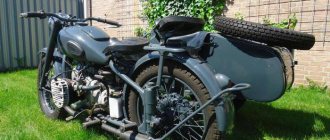- Story
- Interior
- Exterior
- Video
The American car FORD F-650 is the largest mass-produced SUV in the world. Originally designed as a pickup truck and intended to carry heavy loads and/or be used as a tow vehicle, this huge vehicle has become a favorite among Americans, who increasingly use it in everyday life.
A little history
Passenger cars with an open cargo bed first appeared in the early 20th century, becoming an intermediate link between trucks and cars. Their commercial use began after leading US automobile companies began serial production of pick-up vehicles.
First generation F-series pickup FORD
Among them was the FORD company, which in 1919 released the mass-produced Ford T farm pickup truck.
Unlike European ones, American pickup trucks were developed on the basis of a rigid frame chassis coupled with a comfortable cabin of a passenger SUV. Distinguished by their increased carrying capacity and the presence of a powerful power unit, they have been positioned as farm vehicles for quite a long time.
1973 FORD F-150
Overseas, pick-up cars are still in high demand. The history of the development of F-series pickups proves this. The first cars of this series appeared in 1948 and were immediately loved by practical Americans.
The most famous of them is the FORD F-150 (1973 - present), which, constantly changing, has become the sales leader among trucks in the USA over the years.
2015 FORD F-150
Successfully combining time-tested technical solutions with the latest modern technologies, Ford Motor Company is now mass-producing the 13th generation of full-size pickup trucks in this series.
FORD F-150 Raptor SVT
In Russia, the most famous is the sports version of the FORD F-150 Raptor SVT pickup truck, first shown in 2008 at the SEMA 2008 auto show (Las Vegas).
Development
The model line released as successors the F-600, F-700 and F-800, which were the manufacturer's largest vehicles in North America.
Their production was completed in 1998. The need to develop a new model was due to the fact that these vehicles had been produced without any significant technical changes since 1980. In order to reduce the cost of developing a new car, Ford carried it out jointly with the truck manufacturer Navistar International, which was also interested in replacing the long-running International S-Series/4000-Series model. The new joint venture was named Blue Diamond Truck Company LLC. The essence of the cooperation between manufacturers was to use a common chassis. At the same time, each of them developed their own medium-duty trucks. International used its own engines for them, while Ford equips its models with engines from other manufacturers.
As on previous cars, the Ford F-650 was equipped with cabs from pickup trucks, only this time they used parts from the Super Duty line. In this regard, previously unavailable modifications with one-and-a-half and 4-door cabs appeared. The cabins were equipped with a large hood with separate bumpers. The lighting fixtures were left over from previous models.
Story
The F-650 has two generations.
The first was produced from 2000 to 2015. During production, the car underwent two updates. The first of them, produced in 2004, was very modest and consisted only of changing the design of the radiator grille. In 2012, the interior was modernized. It was designed in the same design that was used on Super Duty pickups in 2011.
The second generation car was introduced in 2015. The cabin received a new hood, radiator grille, fenders, and headlights.
Body
Hyundai accent 3rd generation: photo, price, technical characteristics, video test drive of the car
The Ford F-650 chassis has a frame design traditional for pickups.
A cabin is installed on it. The car is equipped with single (2-door), one-and-a-half (2+2 doors) and double (4-door) options, also traditional for American pickup trucks.
The difference between the Ford F-650 and other cars of this kind is that it was originally developed for commercial use, and only later did civilian versions appear. In this regard, the machine can be equipped with various options for superstructures, which are relatively easy to change, which is especially convenient for commercial applications. For example, a tow truck platform, a concrete mixer, a residential module, etc. can be installed on a Ford F-650.
Naturally, the dimensions of the car are determined by the superstructure with which it is equipped. The following are the dimensions of the pickup truck. Its length is 7.696 m, width - 2.433 m, wheelbase - 4.927 m. Thanks to this, the Ford F-650 is the largest pickup truck. Its mass is about 12 tons.
Place on the market
In the US and in the local market, the Ford F-650 occupies completely different positions.
At home, it was initially developed as a commercial vehicle, and there the car is widely used for its intended purpose. For example, it is used by construction and transport companies, evacuation services, etc. However, the car also gained popularity among private users, as a result of which civilian versions of the Ford F-650 appeared. Tuning it has also become widespread. Private users used it in the form of a traditional pickup truck, motor home, tractor, etc. The breadth of use of the vehicle in question for both commercial and private purposes is determined primarily by the ease of replacing superstructures. Thus, it can be used to mount a folding body, a living or cargo compartment, construction or coupling equipment, etc. In addition, similar models are produced in the USA that are competitors to the F-650: International Durastar and Freightliner Business Class M2.
In the local market, much cheaper and more economical Korean and Chinese models are preferred as mid-level commercial trucks. They are usually equipped with 4-cylinder diesel engines, unlike the Ford F-650. Fuel consumption is therefore significantly lower. As for private use, this car also did not gain popularity here for several reasons. Firstly, it was not supplied to the local market, so it is very difficult to find a used copy here. Considering how much a Ford F-650 costs if you import it from the USA through customs clearance, it is easier and more profitable to purchase any officially supplied full-size SUV. Secondly, operating this car is difficult. Due to its high fuel consumption, it is not advisable to use it as a family car. In addition, the size makes urban use difficult. Finally, a test drive of the Ford F-650 indicates that the driving performance of many full-size SUVs is significantly superior to it. This is due to size, weight and leaf spring suspensions, while any large SUV is smaller, lighter, and some have independent suspensions. Therefore, the few Ford F-650s that are in Russia are usually used as exclusive fashion cars or exhibition pieces.
The largest production car Ford F650
Ford Focus 4 2018-2019 photos, videos, technical specifications of the new generation Ford Focus
The Ford F650 pickup truck is recognized as the largest vehicle ever produced. According to information recorded in the Guinness Book of Records, its length is almost 7.7 m, width – 2.4 m, and weight is about 12 tons. This car is called the “king of the roads” and its price is royal. The basic package costs from $80 thousand, and the option “packed” with additional options can cost $300 thousand.
Despite the power of 350 hp, the car does not surprise with its speed; its maximum is 121 km/h. This Ford runs on diesel fuel and consumes an average of 19 liters of diesel fuel per 100 km. The capacity of the gas tank in the basic configuration is 255 liters, and in the tuned version up to 405 liters. For comparison, with such fuel consumption, the price of such a taxi would skyrocket.
The Ford F650 went into production in 2000, replacing the previous generation F-600, F-700, and F-800, which had been in production since 1980. The model was used mainly as utilitarian vehicles for towing, transporting heavy loads in construction and public utilities. The F650 was intended primarily for companies and municipalities. Surprisingly, the car has a good chance of getting into the role of Reutov’s taxi - today it is used in a slightly converted form for wedding processions.
The first vehicles in the series were Class 6/7 trucks, but the F-750 was reclassified as a Class 8 at 37,000 lb (17,000 kg) due to body and chassis upgrades.
The F-650 and F-750 are manufactured in Mexico in a joint venture with Navistar International called Blue Diamond Truck Company LLC.
As of 2014, the Ford F650 medium-duty Super Duty is available in the United States, Canada, Mexico and Brazil.
Pickup truck classification
Currently, having gone through a rather difficult development path, characterized by periodic drops and surges in consumer demand, the following types of pickup trucks are produced in the United States:
- cars;
- compact;
- mid-size;
- full-size, version categories:
- light, the load capacity of which does not exceed 1200 kg;
- heavy, capable of carrying cargo weighing more than 3.5 tons.
- giants - built on the basis of light or medium trucks.
The FORD F-650, production of which began in 2001, falls into the latter category. It is produced at Blue Diamond Truck Company LLC, whose facilities are located in Mexico.
Engines
UAZ Patriot: review, test drive and technical characteristics of the SUV
The first generation car in question was equipped with four engines.
Caterpillar 3126/C7. These are in-line 6-cylinder diesel engines with a volume of 6.7 liters, equipped with turbocharging. They exist in ten versions and develop from 323 hp. s., 772 Nm up to 362 l. s., 1164 Nm. Since 2000, a 3162 engine was installed. A little later, this engine was replaced with a C7, which was used until 2009.
Cummins ISB. This 5.9 liter power unit of a similar design was used from 2000 to 2006.
Cummins ISB. In 2007, it replaced the previously discussed engine. This is a 6.7 liter engine of the same design, presented in ten versions. Its performance ranges from 220 liters. s., 704 Nm up to 360 l. s., 1083 Nm. This engine was used until the end of production of the first generation Ford F-650, that is, until 2015.
Ford Modular. This 6.8-liter V-shaped 10-cylinder power unit has been in use since 2012. It is the only naturally aspirated gasoline engine available for this car. Unlike the engines discussed above, it existed in one version, developing 362 hp. With. and 619 Nm.
For the second generation Ford F650, two engines are available from the manufacturer’s range. One of them is the 6.8 liter V-10, described above, which was also used on the first generation of the model. The second is a new motor, discussed below.
The Ford Modular V-10 in the new F-650 produces 320 hp. With. power and 623 Nm of torque.
Ford Power Stroke. This 6.7L V8 engine is the first mid-performance diesel engine developed by Ford. On the F-650 it is available in three variants. In the standard version, its power is 270 hp. s., torque - 914 Nm. 300 l capacity options are available as an option. s., 948 Nm and 330 l. s., 982 Nm.
Tuning
The FORD F-650 is a car that is incredibly popular among companies specializing in vehicle tuning. They purchase it for modification and use it to create completely unusual machines.
So EarthRoamer, one of the most famous tuning studios in the USA, recently completed the development of a new XV-HD trailer. The basis for this model was the chassis of the giant Ford 650 pickup truck.
The result of the work was a spacious mobile home with the following overall dimensions:
- length, m - 10.6;
- width, m - 2.594
- height, m - 3.96.
Tuning FORD F-650
Thanks to these dimensions, the trailer can easily accommodate up to 8 people, but the number of beds is designed for 6 people.
In addition to the kitchen, the trailer is equipped with:
- refrigerator with freezer;
- water heater.
It is also equipped with air conditioning and heating systems. Also optionally installed:
- washing machine;
- Dryer.
The vehicle is powered by a set of batteries, which are charged by solar panels during long periods of parking.
The trailer is equipped with a diesel engine of the PowerStroke family. Its power is 330 hp, and its cylinder volume is 6.7 liters. This engine is coupled to a six-speed TorgShift automatic transmission.
Gravity flow backwards
The Tin Lizzie engine was developed by Henry Ford himself back in the early 1900s and was subsequently refined many times. It was an in-line four-cylinder gasoline engine with a side camshaft and valve mechanism. The block was cast from cast iron in one piece along with the water jacket of the cooling system, which was a technological breakthrough for those years. The ignition of the air-fuel mixture coming from the gravity carburetor of the Kingston system was ensured by a magneto generator connected by a belt directly to the engine shaft. The compression ratio was only 4.5:1, which made the engine very reliable during long-term operation. With a volume of 2.9 liters, it produced only 22.5 hp. power and 112 N•m of torque. But for a very light car weighing only 540 kg, this was quite enough. Gasoline flowed from the carburetor by gravity, and when driving uphill, sometimes the engine simply stalled. Therefore, the method of overcoming the climbs was unusual - in reverse! The process of starting the engine involved the use of a manual starter, that long-forgotten “ringleader”. Cranking the starter required skill. Dislocated fingers of the right hand were common, which was reflected in American jokes of those years. The engine was quite noisy, despite the presence of a muffler. It was direct-flow and made of thin sheet steel with asbestos gaskets between the components.
The clutch assembly was a simple wet type - three thick steel discs in an oil bath transferred the flow of torque to the shaft of a two-speed planetary transmission developed by Ford itself. All gearbox shafts and gears were cast from hardened vanadium steel. Model Ts that survive are usually in excellent condition. The lubrication system was common to the entire power plant, including the engine, clutch and gearbox, and held approximately 4 liters of engine oil. Ford engineers did not think of making a dipstick to measure the level, and drivers filled in oil until it began to flow out of the hole on the top cover of the engine. In the early years of production of the Tin Lizzie, Ford purchased radiators for the water cooling system in France from the Briscoe company, and then began making them on its own. On the front side was a large bronze Ford Motor Company emblem. The fuel tank was located under the seats and connected to the frame with steel clamps. Its capacity was 37.5 liters. Not very much, considering that the fuel consumption of the Model T was highly dependent on the nature of the road and the speed of travel and varied from 11 to 19 liters per 100 km. The maximum speed of Tin Lizzie was about 70 km/h, although the specimens that participated in the then fashionable auto racing reached up to 150 km/h. It’s scary to imagine the sensations of a racer flying on a projectile without normal brakes and on wooden wheels at such a speed.
Simple, even simpler
Technical characteristics of Ford Focus III 1.0 MT 2012 - present
The Tin Lizzie, like its Model N predecessor, was built on a heavy-duty load-bearing steel frame with two longitudinal beams and 1/8-inch-thick steel plate transverse stiffeners. It was made for Ford at the Michigan Stamping Company. A 2.9 liter Henry Ford engine was attached to the frame, along with a primitive but reliable two-speed transmission, leaf spring suspension and a body. There were many body styles in those years, and automakers called them each differently. Six body styles were initially developed for Lizzie - Touring, Runabout, Landaulet, Town Car and Coupe, but in 1908 the Model T was produced only in Touring and Landaulet variants. The bodies were ordered from third-party manufacturers in Detroit. The upholstery of the open modifications was made of thick black genuine leather with a special “diamond” finish. A fabric top, made from canvas painted grey, dark red or dark green, was an optional extra. In closed Lizzies, only the seats were trimmed with black leather, and the interior door trim was made of leatherette.
Contrary to popular belief that Model Ts were only painted black, this practice actually began only in 1913 with the start of assembly line assembly. And before 1913 there were no black Tin Lizzies at all! Buyers could choose grey, dark green or dark red exterior colours. The windshield was not included as standard and had to be ordered separately. At the same time, a transverse steel beam was installed in the wooden partition between the engine compartment and the passenger compartment, reinforced with bronze strips, for rigidity. Otherwise, the glass would simply burst on potholes, because the body of the Model T began to creak within a few days after purchase. The interior equipment was, to put it mildly, spartan. A large wooden steering wheel with a diameter of 36 cm with bronze spokes was tightly screwed to the end of the steering shaft. Below it on the right were two short bronze levers with hard rubber knobs. One lever controlled the fuel supply, and the other controlled the ignition.
The first two thousand copies of the car had two pedals on the floor and two large levers to the left of the driver's seat, then there were three pedals and only one lever. The left pedal engaged first gear, the right pedal engaged the rear wheel brake and reverse gear. The levers were responsible for reverse gear, activation of the transmission brake and neutral gear. The controls were quite complex and it took quite some time to learn how to drive Tin Lizzie. In the instructions of those years, the driver was recommended to press both pedals simultaneously and pull the transmission brake lever back all the way to make an emergency stop. The car stopped dead in its tracks. The speedometer was not standard equipment on the Model T; the Ford Motor Company purchased these instruments in Detroit from Stewart, National and Jones.
The First Swallows Ford Model T cars, assembled from 1908 to 1909 at the Pickett plant, are now considered very rare and worth a lot of money. The first models of the Pickett plant were Model C, F and B. On the second floor, the Model B chassis and bodies were assembled, and the third was dedicated to the production of Model C and F. At the end of 1906, production of these models was discontinued. And in April, after a slight re-equipment, the plant began producing new Model K, R, S and S Roadster. Three months later, in July, the promising Model N appeared, which became the basis for the future Tin Lizzie. At the end of the winter of 1908, after the completion of the preparation of technological documentation for the newest Ford Model T, the accelerated re-equipment of the enterprise began. The previous models were discontinued and only the Model K assembly continued for some time. But soon it was stopped. And on September 27, 1908, the first ever copy of Tin Lizzie was assembled, which was sent to the first buyer, a wealthy doctor from Detroit, on October 1. Even before the assembly of the Ford Model T began, it became obvious to Henry Ford that the area of the Pickett plant was insufficient to implement his plans, and he began to look for a place to build a new large assembly plant. In late 1908, construction began on a plant on a plot of land in Highland Park. The building on Pickett Avenue was owned by the Ford Motor Company until January 1911, when it was sold to another famous auto company, Studebaker. Experts claim that of the 12 thousand original Model T Piquette, no more than 100 copies remain to date.
Chassis
The first generation F-650 was equipped with dependent leaf spring suspension as standard, and an air rear suspension was available as an option.
The same situation is with the second generation of the car. The front suspension is represented by a design on parabolic conical springs. Optionally, a reinforced suspension is installed. At the rear there is a structure on multi-leaf springs. Reinforced suspension is available as an option, and diesel versions can be equipped with air suspension.
The F-650 comes standard with hydraulic brakes. For some versions, pneumatic mechanisms are available as an option.
Transmission
For the first Ford F650, transmissions from four manufacturers were available: Ford, Allison, Eaton-Fuller, TTC Spicer. Only diesel versions were equipped with a 6-speed automatic transmission of our own production. There were 5 Allison automatic transmissions available for the car: 4 5-speed options and 3 6-speed options. Eaton supplied only manual transmissions in 5 options: 1 5-speed and 4 6-speed. Spicer provided 2 7-speed manual transmissions.
For the second generation Ford F-650, only a 6-speed automatic transmission of our own production is available for both engines.
Ford F650 review
In 2001, production of the largest pickup truck in the world began. But in fact, this vehicle is a commercial truck that will be introduced in its second generation in 2021. Initially, it was assumed that the Ford F650 would be of interest to cargo carriers or builders as special equipment, but some tuning studios turn it into limousines for parties or for trips around the city.
Design
Externally, the car looks very aggressive and unusual. Essentially, it looks like an average American pickup truck scaled up twice. One of the first things that catch your eye are the huge 22.5-inch wheels and a very large number of chrome elements on the body.
The Ford F650's interior features luxurious woodgrain trim that would be the envy of some executive cars. The seats are made of leather and heated, climate control and high-quality multimedia are also installed.
Comfortable movement of the driver and passengers is ensured by air suspension. The standard tank has a volume of 220 liters, it is possible to install additional tanks of 400 liters. The maximum speed is limited to 120 km/h due to the large mass of 12 tons and poor aerodynamics.
Engine and transmission
A 24-valve V-shaped turbocharged diesel unit with a displacement of 5.9 is installed under the hood; 6.7 or 7.2 liters, with a developed power from 220 to 370 hp. With. with torque from 570 to 800 Nm. The car is equipped with a 6-speed automatic transmission from Allison. At the same time, fuel consumption in “gentle” mode on the highway is about 15 liters, and in the city it is more than 25 liters per 100 km. Rear axle ratio - 4.88;
Dimensions
Ford F650 reaches 8 meters in length and 2.5 meters in width. The wheelbase, depending on the body, is from 3.4 to 7 meters.
Equipment
- Chrome bumpers;
- Two-tone leather interior;
- Climate control;
- Pair of 405 liter fuel tanks;
- Custom King shock absorbers;
- Electric windows and mirrors;
- Rear View Camera;
- Three LCD monitors;
- Stereo system with subwoofer and amplifier;
- Auto start system;
- Aluminum radiator grille;
- A roof with a panoramic view;
- Chrome mirrors and door handles;
- Diode rear optics;
- Goodyear tires;
- Tinted rear windows;
- Fog lights.
Bottom line
As standard, the car comes in a pickup truck. There are also factory configurations in a limousine body. The Ford F650 is sold only in the USA and is used there by firefighters, police and rescue services, as it has good cross-country ability and reliability.
A new model will be introduced in 2021. It will have a heavily redesigned cabin design and a new power unit and transmission. Now the car will be able to run on liquefied gas, which will reduce fuel costs.
The Ford F650 is not practical in the city. The main focus is long-distance trips and off-road travel. The car is fully adapted for the American consumer. In Europe it is completely unsuitable. In Russia, this is a “toy” for rich people, since maintaining the world’s largest pickup truck is very expensive.
Ford F-750 Dunkel Luxury Hauler 4x4
Review of Mercedes-Maybach S-Class 2018-2019 - technical specifications and photos of
Ford F-750 Dunkel Luxury Hauler 4x4
Prehistory
The Ford F-650 is recognized as one of the largest production cars in the world. Initially, this car was called the F-600. Its production was launched in 2001. The full name of the pickup truck is Ford F-650 Super CrewZer. The car went on sale in 2002. Since then, several improved models have been released.
Under the hood of this pickup truck there are several engine modifications to choose from - with power from 200 to 350 hp. With. (5.9L Cummins Turbo Diesel, 7.2L Caterpillar Turbo Diesel or 6.0L Power StrokeV8 Turbo Diesel). In 2012, it was decided to also produce gasoline and even gas engines as an option. Needless to say, Americans love cars with impressive dimensions. This giant mammoth, produced by the North American automaker Ford Motor Company, reaches almost three meters in height.
And it weighs more than 10 tons.
The maximum speed of this mammoth is only 112 km/h, but this is acceptable given such impressive dimensions and weight. Fuel consumption is 13 liters per 100 kilometers (at maximum speed). Therefore, some models have as many as two fuel tanks with a capacity of over 400 liters. There are both all-wheel drive modifications and conventional ones. The Ford F-650 is also sold in Russia.
The Ford F-650 can be called a true automotive phenomenon. The muscular giant is dressed in a tailcoat of industrial design elegance - he is a true millionaire farmer who is not afraid of hard work.
Despite its impressive size and aggressive design, the Ford F-650 has many of the luxury features expected of an executive limousine, such as leather and wood trim, heated seats and powerful air conditioning, as well as a CD-capable audio system. In addition, there are LCD monitors included in the entertainment package.
Tuning experiments
Naturally, the Ford F-650 was not conceived as a “large pickup truck for country family walks,” but as a good tractor, a powerful towing vehicle, and a truck that can be used in many ways at a construction site. But the car was liked by “ordinary people,” and popular tuning studios went a little further - and, as happened with the well-known military car Hummer, the F-650 acquired another life in the form of elongated luxury limousines and cars with extensive tuning and modifications.
Inside you can find an audio installation of 42 speakers and a 107 cm diagonal TV, and somewhere under the bottom there is a whistle from a steam locomotive! Such a miracle of technology will cost 200 thousand dollars.
Ford F-750 Luxury Hauler 4x4 Dunkel Bros. Edition
Dunkel Bros. built a monster-like motor home Ford F-750 Dunkel Luxury Hauler 4x4
There were also people (Dunkel Bros.) who decided that the multi-ton F-650 “super tanks” were still not big enough. And on the basis of the F-650 they built a monster-like motorhome Ford F-750 Dunkel Luxury Hauler 4x4 - a huge, longest off-road pickup truck with a trailer.
Its length (without trailer) is 9.7 meters, width – 2.5 m, height – 3.6 m. Under the hood it has a 7.2-liter Caterpillar diesel engine.
In addition, it has:
- frame structure
- all-wheel drive
- air suspension
- three winches
- video cameras all around
- navigation
- two TVs
- kitchen
- gas
- refrigerator
- toilet
- shower
- air conditioning system
- audio system
- several places to relax
In addition, the interior contains elements of leather and wood trim.
FORD F-650
The FORD F-650 (full name: FORD F-650 Super CrewZer) is listed in the Guinness Book of Records and is one of the most recognizable cars in the world. This is facilitated not only by its huge dimensions (7,696x2,433x2.2 m) and weight (about 12 tons), but also by the original exterior of the body. Compared to it, even cars like the FORD F-150 Raptor or Hummer seem small.
Exterior
The body design of this truck-like vehicle is varied. This is due to the fact that each copy is selected for a specific owner and manufacturers have the opportunity to take into account all the wishes of each of them. Therefore, on the road you can find cars that differ from each other not only in the shape of bumpers, fenders or trunk, but also in different body styles. In addition, there are no restrictions in the choice of colors and exclusive designs.
However, despite the fact that the car can be made in a pick-up, station wagon or limousine type, each of them has characteristic features that make it possible to clearly determine that this is a FORD F-650. These include:
- large radiator grille with the company logo, made of a special alloy (aluminum + magnesium + silicon);
- wide front bumper beam with winch mount;
- fuel tanks made of stainless steel, installed instead of side sills and acting as steps;
- 22.5-inch wheels with Goodyear UnisteelG15 22.5x8.2 tires.
More on the topic: New Gazelle business - a new level of reliability
Currently, the following versions of this one-of-a-kind vehicle are produced in the United States:
- Farmer pickup truck FORD F-650 Dominator.
- Special purpose vehicles (for fire, medical and police services).
- The Super Duty SUV has unique cross-country ability with a ground clearance of half a person's height.
- An SUV with a large interior designed for 10 passengers.
- The elite limousine FORD F-650 Mammoth (Mammoth) is the largest limousine in the world.
FORD F-650 Dominator
FORD F-650
FORD F-650 Mammoth
Interior
Seat upholstery Ford-F650
The interior of the spacious cabin has virtually no flaws and fully matches the design of the body. It's simple but surprisingly cozy
Noteworthy are the heated leather seats and the informative instrument panel.
The center console contains measuring instruments that are installed optionally, as well as a differential lock button, transmission temperature indicator, exhaust brake button, etc.
Ford F-650 interior
The basic equipment of the cabin also includes:
- Rear View Camera;
- high-quality acoustics with subwoofer;
- autonomous engine start;
- light and rain sensors;
- climate control.
The number of seats varies depending on the version and in some models the cabin can accommodate up to 22 passengers.
Since these cars are equipped to meet the requirements of a specific customer, you can also find models equipped with a large number of different options, including the following:
- air conditioner;
- electric windows;
- 40" clear hatch;
- tinted windows;
- navigation system;
- on-board computer.
In addition, the comfortable VIP-class versions are distinguished by two-tone leather trim with natural wood inserts and are additionally equipped with:
- XLT Trim Package;
- Entertainment Package Ft. with three televisions and a class V radio.
Model range and prices of Ford cars Ford
According to legend, Henry Ford, the future founder of the American brand, fell from his horse while working on his father's farm and was hit hard. Then he first thought about creating a vehicle that would not require the use of animal force.
In 1903, Henry managed to make his dream come true: a new industrial plant, Ford Motor Company, opened in the building of a small van factory in Dearborn (USA, Michigan). The first American Ford A that any teenager could drive. Many of the models of the first five years did not reach the end consumer, remaining at the experimental level.
After all his efforts, luck finally smiled on Henry Ford: the 1908 Ford T model (colloquially known as “Tin Lizzie”) became widely known and gave impetus to mass production. The low price of the Ford T - only $260 - caused high demand: in the first year alone, more than ten thousand of these cars were sold. After the introduction of the conveyor assembly method at factories, the process of its creation became even more cheaper: every 10 seconds another Ford T model left the gates of the Ford Motor Company.
Pickup trucks, vans, and even small buses built on the Tin Lizzie base rolled off Ford's assembly lines. Many of them even formed the basis for the products of the Gorky Automobile Plant (GAZ) of the USSR. Despite the variety of body modifications, all produced cars were united by Henry Ford's favorite color - black, for which the Model T was often compared to an old maid in a black dress and hood.
The founder paid much more attention to improving technical equipment and increasing passenger safety. It was at Ford factories that monolithic V-shaped “eights” and “safety” glass first appeared. The most important aspect of the American company's policy has always been to reduce the risk to human life. Ford's worthy characteristics allowed the cars to become real favorites of practical Americans, and in the 30s they gained popularity among countries around the world. By the beginning of World War II, the company already had a huge network of factories and stores in the United States and opened new branches in Europe and Russia.
Due to the military situation in the early 40s, the production of civilian cars stopped abruptly, as all efforts were aimed at creating motor bombers, aircraft engines, tanks, and anti-tank installations. Henry Ford's reputation as a member of the Ku Klux Klan was far from impeccable, but the state turned a blind eye to his pro-Nazi views and in 1946 awarded him for his services to industry and the country. A year after this event, the founder of the Ford Motor Company died, and the reins of the company passed to his grandson Henry Ford II.
The production of American brand cars was aimed primarily at young buyers: the company created inexpensive sports cars. The original combination of design trends of the 50s and 60s was embodied in the legendary “bestseller” Ford Mustang, which debuted in 1964.
The car market was replenished with new models from various manufacturers, and by 1976 the company had a need to create a corporate logo. Against the background of fierce competition, Ford specialists began to introduce new technologies in the field of fuel economy.
Armed with the goal of creating a world-class leader in the midsize and executive segments, Ford Motor Company introduced models such as the Ford Mondeo, Mercury Sebale, and Taurus. The latter was recognized as the car of 1986, and a year later became a real American bestseller.
In the 90s, the premieres of Ford Espaillat and Windstar minibuses took place.
Continuously improving products while lowering costs is the goal of Ford, with locations around the world. In 2002, a Russian full production cycle plant was opened in Vsevolzhsk (Leningrad region).
Now Ford is the world's largest manufacturer and produces cars of various sizes, purposes and price categories: from small cars to SUVs and minivans.
Model history
The F-series from Ford dates back to 1949. It's hard to believe, but this series of cars has survived as many as 13 generations. Today there are 3 modifications of cars in the line, which differ in size and power. This review will focus on the F650. Ford, whose technical characteristics and off-road qualities are amazing, can hardly be called an ordinary jeep or SUV. Most likely, it is a transition link from a jeep to a truck from the same company. The production of the F650 model began in 2000. In 2013, the car underwent some changes and restyling, after which it is produced in the latest version to this day.
Initially, the formulation of the concept of this car sounded like this: the largest non-commercial car. As time has shown, the F650 Ford, whose technical characteristics are comparable to full-fledged trucks, is commercial to the core. Its buyers are ardent fans of large pickup trucks and their tuning, or companies purchasing a platform for future earnings. After all, Ford produces this model in the form of a chassis and cab. This is done so that the buyer can determine the scope of use of the jeep and complete it.
After the appearance of the first F650, there was a wave of popularity for tuning studios, which gave the already formidable jeep an even more terrifying look. Some craftsmen even tried to improve the car's passability, although it absolutely does not need it. Despite all the brutality and impracticality in urban conditions, these jeeps are constantly found on the streets of the United States as family cars or a kind of toy for the owner’s entertainment. It's not uncommon to see the F650 as a workhorse.
Specifications
FORD F-650 has good dynamic parameters for its weight and dimensions. Of course, it cannot be classified as an amazing “lighter” (cars that accelerate to 100 km/h in no more than 9 seconds), but the speed of 120 km/h that this “mammoth” is capable of developing on the highway is no less impressive. At the same time, according to the manufacturer, fuel consumption does not exceed 13 liters per 100 km. True, the results of tests (test drives) indicate that real fuel consumption is much higher - 20...21 l/100 km.
The power steering provides precise control and smooth steering rotation.
As standard, the car is equipped with fuel tanks holding 255 liters of fuel. However, it is possible to install additional tanks that allow you to increase the amount of fuel to 405 liters.
Powertrains, transmission and suspension
FORD F-650 manufacturers offer potential customers a fairly large selection of power plants. Thus, the base model in the pick-up body is most often equipped with a gasoline engine of the Triton V10 family with a traction power of 362 hp. This 10-cylinder engine (cylinder volume is 6.8 liters) has enormous power development potential (torque 620 Nm).
It is also possible to install other power plants, among which you can find:
- Ten-cylinder engine Super Crew Cab 7.2 L with a cylinder capacity of 7.3 liters and a traction power of 350 hp.
- Ten-cylinder SD Pro Loader XL Diesel engine with a cylinder capacity of 6.7 liters and a traction power of 362 hp.
- Diesel units from Caterpillar, with a capacity of 310 hp (cylinder volume 7.2 l) or 200 hp (cylinder volume 6.7 l).
- Engines with a traction power of 362 hp, but running on gas fuel:
- Straight Frame XL Gas;
- SD Pro Loader XL Gas;
- SD Straight Frame XLT Gas.
More on the topic: Citroën Type H – the iconic pig
All power units installed on this huge car are combined with a six-speed automatic transmission (automatic transmission) Allison RDS 3000 6-speed transmission with 4x4 or 2x4 drive. Moreover, all-wheel drive is implemented using special technologies developed exclusively for this model.
The 18,500 lb Air Suspension Cap with Custom King Shocks absorbs vibration effectively and handles small potholes with confidence.
External links
Media related to Ford F-Series Super Duty (F-650/F-750) at Wikimedia Commons
Ford F-650-F750 Official page
| « previous — Ford Motor Company light truck timeline, United States & Canada, 1980s–present | |||||||||||||||||||||||||||||||||||
| Type | 1980s | 1990s | 2000s | 2010s | |||||||||||||||||||||||||||||||
| 1 | 2 | 3 | 4 | 5 | 6 | 7 | 8 | 9 | 1 | 2 | 3 | 4 | 5 | 6 | 7 | 8 | 9 | 1 | 2 | 3 | 4 | 5 | 6 | 7 | 8 | 9 | 1 | 2 | 3 | 4 | 5 | 6 | 7 | 8 | 9 |
| Crossover | Subcompact | EcoSport | |||||||||||||||||||||||||||||||||
| Compact | Escape | Escape | Escape | ||||||||||||||||||||||||||||||||
| Mid-size | Edge | Edge | |||||||||||||||||||||||||||||||||
| Full-size | Freestyle | Taurus X | Explorer | ||||||||||||||||||||||||||||||||
| Flex | |||||||||||||||||||||||||||||||||||
| SUV | Bronco II | ||||||||||||||||||||||||||||||||||
| Explorer | Explorer | Explorer | Explorer | ||||||||||||||||||||||||||||||||
| Bronco | Bronco | Bronco | Expedition | Expedition | Expedition | Expedition | |||||||||||||||||||||||||||||
| Excursion | |||||||||||||||||||||||||||||||||||
| Pickup truck | Coupé utility | Durango | |||||||||||||||||||||||||||||||||
| Courier | Ranger | Ranger | Ranger | ||||||||||||||||||||||||||||||||
| Explorer Sport Trac | Explorer Sport Trac | Ranger | |||||||||||||||||||||||||||||||||
| F-Series (all) | F-Series (all) | F-Series (all) | F-150/F-250 | F-150 | F-150 | F-150 | |||||||||||||||||||||||||||||
| Super Duty | Super Duty | Super Duty | Super Duty | ||||||||||||||||||||||||||||||||
| Van | Compact MPV | Transit Connect | Transit Connect | ||||||||||||||||||||||||||||||||
| C-MAX | |||||||||||||||||||||||||||||||||||
| Minivan | Aerostar | Aerostar | |||||||||||||||||||||||||||||||||
| Windstar | Windstar | Freestar | |||||||||||||||||||||||||||||||||
| Full-size | Econoline | Econoline/E-Series | |||||||||||||||||||||||||||||||||
| Transit |
| « previous— Ford Motor Company heavy truck timeline, North American market, 1980–present | ||||||||||||||||||||||||||||||||
| Type | 1980s | 1990s | 2000s | 2010s | ||||||||||||||||||||||||||||
| 1 | 2 | 3 | 4 | 5 | 6 | 7 | 8 | 9 | 1 | 2 | 3 | 4 | 5 | 6 | 7 | 8 | 9 | 1 | 2 | 3 | 4 | 5 | 6 | 7 | 8 | 9 | 1 | 2 | 3 | 4 | 5 | 6 |
| F-Series Super Duty (F-650/750) | Super Duty | |||||||||||||||||||||||||||||||
| Conventional | L-Series/"Louisville" | Louisville | ||||||||||||||||||||||||||||||
| Cabover (COE) | C-Series | |||||||||||||||||||||||||||||||
| Cargo | LCF | |||||||||||||||||||||||||||||||
| CLT-9000 | ||||||||||||||||||||||||||||||||
| Bus |
FORD F650 interior
This may seem strange, but this practically truck, designed for work on construction sites, for all its impressiveness, is not much different from a conventional passenger car (except for size, of course) in comfort, ease of placement and a full range of electronic devices. The basic configuration includes electric locks and windows, a remote start function, and automatic daytime running lights that turn on the headlights when the level of outside lighting decreases. The built-in rear view camera will allow you to see and assess the situation behind the car in great detail through the rearview mirror. Agree, this is very difficult to do with ordinary exterior mirrors.
The entertainment center, including 3 TV, CD player and V-class radio, provides excellent premium sound thanks to a powerful amplifier and subwoofers.
The air conditioning provides a comfortable microclimate, and the hands-free system allows you to receive phone calls via Bluetooth Audio, controls equipment and the entertainment center through voice commands, reads SMS messages aloud to the driver, and much more. Front panel controls and instruments are intuitive and easy to operate. In addition, there are two options for leather trim, one- or two-color. In addition, there are two options for leather trim, one- or two-color. It should be noted that this is only the standard set of the car. Design variations provide for a richer interior finish - natural wood trim, high-quality leather, heated seats, a CD player with a changer... It all depends only on the imagination of the designers, and there is plenty of room for their implementation.
The New 2012 Ford F-650 Is a Construction Monster
Ford is one of the world leaders in the sale of pickup trucks. For example, F-series pickups are popular in America. More recently, the auto giant created something fascinating. A huge pickup truck based on the F-650 pickup truck. This powerful pickup truck ended up in the hands of the guys from Truck Trend. Testing began in Las Vegas and continued in Los Angeles. As you know, Las Vegas is the only city in America where there are sites for test drives of heavy equipment - excavators, tractors, bulldozers. This type of equipment also includes the Ford F-650.
Looking at its impressive dimensions, you might think that this pickup truck belongs to the monster Super Duty Truck class, where the load capacity is over 5 tons and the towing force is over 8 tons, but no, it belongs to the younger class - Medium Duty Truck. This class has a load capacity of up to 5 tons and a towing force of up to 8 tons.
This giant, 6.5 meters long and weighing almost 5.2 tons, turned out to be very easy to control. The truck with a wheelbase of 5 meters demonstrated excellent stability and maneuverability. All pedals are much easier to press than other Medium-Duty F-Series pickups. The Ford F-650 is equipped with a 6-speed automatic transmission, which, according to testers, is the most suitable option for this pickup truck.
After touring the entire site in Las Vegas, the guys decided to continue testing in Los Angeles. On the highway, the Ford F-650 showed what its capable engine can do. V-shaped ten with a volume of 6.8 liters and a power of 362 hp. / 619 Nm worked at full capacity. At a speed of 150 km/h, the cabin shook slightly. If it were not for the Air Ride function (suspension system for the driver's seat), the driver would clearly have a hard time. The acceleration speed of the F-650 truck was amazing, it took just 17.6 seconds to accelerate to 100 km/h. As for braking, it came to a stop from this speed to 0 in less than 50 meters.
An interesting fact is that anyone with a class 3 license (similar to our category B license) can drive such a pickup truck. It is not at all necessary to pass for any particular category.
The distance to Los Angeles is minimal, so the trip was short, but hot. Once on the construction site, the team from Truck Trend decided to test the body's capabilities. So, the red light on the dashboard came on, which means that the truck has prepared its mega body for work. Just a few maneuvers with the control lever and the cargo compartment begins to slowly rise, without any creaks, twitches or shakes. Using a towing hook, the testing team hooked several bundles of heavy metal beams and loaded them into the bed of a pickup truck without any problems. Then a pile of stones, a mountain of sand (of course, not without the help of an excavator), wooden beams and other building material flew into the body. The guys tested the pickup truck in every possible way. Watching the Ford F-650 in action, you get the impression that this car can do absolutely anything, and nothing is impossible for it.
In conclusion, testers concluded, "The Ford F-650 is a giant work tool that couldn't be easier to operate."
In fact, in Russia, pickup trucks of this size could be popular. Still, we are sorely lacking in good commercial transport, there are just a few “buts”. Such a truck will never be classified as a “B” truck and let its intended owner park the F-650 near the house. In response, he will receive a note with rather piquant content.
Photos of the monster Ford F-650
First generation 2000-2015
2002 Ford F650 Super Duty alongside a 1989 Ford F600
2004–2015 F-750 Super Duty in use servicing a water pump
For the 2000 model year, Ford introduced the medium-duty variants of the Super Duty lines to replace its F-600, F-700, and F-800 that were discontinued in 1998. After the sale of the Aeromax/Louisville truck line to Freightliner in 1997, these had been the largest vehicles produced by Ford in North America. Although they saw a minor update in 1995, the medium-duty F-Series had not seen any major changes since 1980.
To decrease development costs on a new truck line, Ford entered into a joint venture with truck manufacturer Navistar International, who was looking to develop a replacement for the long-running International S-Series/4000-Series. Named Blue Diamond Truck Company LLC
, the two companies would develop their own medium-duty trucks sharing a common chassis; International would use its own engines for its truck while Ford would use off-the-shelf powertrains. International would introduce its version in 2002 as the redesigned 4000-Series (later the DuraStar).
Introduced for the 2000 model year, the all-new F-650 and F-750 variants of the Super Duty line followed the previous Ford tradition of using the cab from the Ford pickup line (this time, the larger Super Duty models) joined to a larger hood with separate fenders. The only visible part shared with previous-generation models were the headlight/turn signal clusters. Along with the standard two-door cab, the crew cab was again available. For the first time, Ford offered the SuperCab on the medium-duty line; it was also available with 4 doors as well as all other Ford SuperCab trucks.
While Super smaller Duty trucks received periodic updates, the only external update to the medium-duty trucks was the adoption of a three-slot grille in 2004. In 2012, the interior was updated; the design seen since 2000 was replaced by the design introduced in Super Duty pickups for 2011.
Specifications
Engine: 6800 cc V-10 Power: 362 hp Transmission: 6-speed automatic Maximum speed: 115 km/h Length: 79696 mm Width: 2433 mm Drive: full Total weight: 11655 kg Seats: 5 Fuel consumption: Average gas consumption 15.7 l per 100 km
It may seem surprising how such a large character, originally designed for cargo transportation, can become a cozy and comfortable means of transportation. But all doubts disappear when you look at the leather upholstery of the seats (the latter, by the way, are equipped with shock absorbers), air conditioning, and electric windows. In general, the Ford F650 will serve well both as a technical assistant and as a hospitable car with five seats for pleasant leisure.
A giant with almost three meters in height, length 79696 and width 2433 millimeters. The “miracle” weighs as much as 12 tons. The decidedly aggressive exterior of the pickup truck is surprisingly embodied in fairly smooth lines. Special emphasis is placed on the wide range of lines of the radiator grille, made of all-alloy material using aluminum, silicon and magnesium. The bumpers, handles and mirrors are chrome-plated, the windows are tinted, the roof has a transparent sunroof, and the painted surfaces of the car have a special protective coating.
If we talk about the engines that the Ford F650 can be equipped with, there may be several options. In the case of the Ford F-650 Super Crew Cab 7.2 L TD, we are talking about a 7.2-liter gasoline engine with ten cylinders and a power of 350 hp.
To cover a distance of 100 km. The jeep will require approximately 15.7 liters of fuel. The F-650 SD Straight Frame XL Gas, SD Pro Loader XL Gas, and F-650 SD Straight Frame XLT Gas are powered by a 6.8-liter gas engine that produces 362 hp. The diesel engine received SD Pro Loader XL Diesel.
The jeep is driven using a 6-speed automatic transmission. There are two types of gearbox: TorqueShift and Allison 2500 WR-RDS, the latter is installed on the diesel version. The giant's suspension is pneumatic, shock absorbers are Custom King.
It is possible to produce front-wheel drive models, as well as all-wheel drive. All wheels are equipped with disc brakes. Regardless of the modification, the driver has power steering, turbocharging, and an anti-lock braking system at his disposal.
In the States, the most unpretentious version of the jeep costs buyers about 60 thousand dollars. The sale of the handsome man in Russia is not officially implemented: a possible method of acquisition is to buy it abroad and then import it into the country, which, of course, will require payment of transportation and duties. Thus, the final price in Russia for a car will be more than two hundred thousand dollars.
What can I say, the Ford F650 creates an impeccable image for its owner, but maintenance will force you to work hard.
Video Ford F 650 test drive
Second generation 2016-present
2016 F-750 catering truck of Beijing Air Catering Co., Ltd.
Introduced at the 2014 National Truck Equipment Association Work Truck Show, the 2021 versions of the F-650 and F-750 bring many changes to the medium-duty Super Duty range of trucks. With Ford discontinuing the Econoline van in 2014, Ford is transferring all of its medium-duty truck production from Mexico to its Avon Lake, Ohio assembly plant upon the end of van production; it will be built alongside the F-53/F-59 front-engine motorhome/commercial chassis.
While the cab itself is carryover, the 2021 medium-duty trucks feature an all-new hood, which features a larger grille and headlights. To save costs, entirely Ford powertrains replaced the outsourced engines and transmissions, and the headlights are shared with the E-Series. In addition to the 6.7L Powerstroke V8, Ford is offering the 6.8L Triton V10 gasoline engine available to buyers; the latter will be available for conversion to propane or compressed natural gas (CNG).

